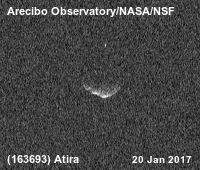小行星163693
163693 阿提娜(/əˈtɪrə/,臨時名稱 2003 CP20)是運行在地球軌道內側的一顆岩質小行星,並被歸類為近地天體。阿提娜是由兩顆小行星圍繞其共同的重心運行的雙小行星系統,主要成員的直徑約為4.8公里(3英里)[8],環繞它的是一顆大小約為1 km(0.6 mi)的衛星 [5]阿提娜是在2003年2月11日被美國新墨西哥州索柯洛附近的林肯實驗室實驗試驗場的林肯近地小行星研究小組的天文學家發現的[2][11]。
 | |
| 發現[2] | |
|---|---|
| 發現者 | LINEAR |
| 發現地 | Lincoln Lab ETS |
| 發現日期 | 11 February 2003年2月11日 |
| 編號 | |
| 命名依據 | Atíraʼ 「我的/我們的母親」[2] (波尼大地女神的綽號)[3]。 |
| 其它名稱 | 2003 CP20 |
| 小行星分類 | |
| 軌道參數[4] | |
| 曆元 23 March 2018年3月23日(JD 2458200.5) | |
| 不確定參數 0 | |
| 觀測弧 | 14.21 yr(5,192日) |
| 遠日點 | 0.9798 AU |
| 近日點 | 0.5024 AU |
| 半長軸 | 0.7411 AU |
| 離心率 | 0.3221 |
| 軌道週期 | 233 日 |
| 平近點角 | 30.769° |
| 軌道傾角 | 25.618° |
| 升交點黃經 | 103.90° |
| 近日點參數 | 252.93° |
| 已知衛星 | 1[5][6][7][8] |
| 與地球最小軌道相交距離 | 0.2076 AU(80.88 LD) |
| 物理特徵 | |
| 自轉週期 | 3.3984±0.0006 h[8] |
| 極黃緯 | −50°[9] |
| 極黃經 | 192°[9] |
| 幾何反照率 | 0.0231 (推導的)[8] |
| 光譜類型 | S (假設)[8] |
| 絕對星等(H) | 16.3[4][8][10] |
它是第一個被發現的阿提娜型小行星成員,因此該分類以它為名。阿提娜型小行星是近地小行星的一個新子類,其軌道完全在地球軌道的內側,因此被稱為地球內側天體(英語:Interior-Earth Objects,IEO)[4][12][13]。截至2019年,已知的阿提娜型小行星成員只有36顆[14]。阿提娜較大部分與阿登型小行星相似,因為它們都是近地天體,都有一個比地球小的半長軸(< 1.0 AU)。然而,與阿登型小行星不同的是,阿提娜的遠日點總是小於地球的近日點(< 0.983 AU)[15],這意味着它不會像一般的阿登型小行星那樣接近地球。「阿提娜」的地球最小軌道交點距離為0.2059 AU(30,800,000 km)或大約80.1 月球距離[4]。
物理性質
編輯「阿提娜」是一顆S型小行星,每8個月(233日)圍繞太陽運行一周,距離為0.5–1.0 AU。它的離心率為0.32,相對於黃道的傾角為26°[4],近日點為0.50 AU,該天體也被歸類為金星軌道穿越小行星 – 金星繞太陽運行的距離為0.72〜0.73 AU – ,但沒有像水星那麼靠近太陽(水星軌道在0.31和0.47 AU)。由於沒有回溯發現的資料,阿提娜的觀測弧始於2003年的發現觀測[2]。它的自轉週期為3.3984小時,亮度變化為0.36星等(U=2) 以及非常低的反照率:0.0231 [8]。
阿提娜的直徑4.8公里,是最大的近地天體之一。早期對其大小的估計從1到2公里不等[11],但這些是基於0.20的較高反照率假設。2017年初,當使用雷達對阿提娜進行成像時,發現了它的低反照率和有着更大的尺寸[5]。這些雷達影像還顯示阿提娜是一顆雙星小行星。
聯星系統
編輯2017年1月,阿提娜距離地球0.207天文單位(31,000,000公里)以內,這是自2003年發現以來距離最近的一次[4]。這為雷達研究這顆小行星提供了機會。2017年1月20日在阿雷西博天文台拍攝的影像顯示,阿提娜是一顆同步的雙小行星,軌道上有一顆衛星:S/2017 (163693) 1[5][7]。直徑為4.8±0.5 km的主星型狀可能是細長的,並且稜角分明。伴星被潮汐鎖定,直徑為1.0±0.3 km。2017年1月23日拍攝的其它影像顯示,這兩個成員相互繞軌道運行,距離約6公里,軌道週期為15.5小時[5][6]。
名稱
編輯由於新一類小行星中第一個已知的天體將成為新一類的名稱,因此對(163693)的名稱給予了慎重的考慮。其它類別的近地小行星,Amors、Apollos和Atens,分別以羅馬、希臘和埃及的神命名,而且每個神都以字母「A」開頭。阿提娜遵循這一模式,以Atiraʼ[ətíɾəʔ]命名,這是美洲原住民波尼人的地球女神的稱謂。阿提娜是創世神蒂拉瓦的妻子,也是地球和昏星之神[2][16]。官方命名的引文由小行星中心於2008年1月22日公佈(M.P.C. 61768)[17]。
相關條目
編輯參考資料
編輯- ^ Atira | 天文学名词 | Astronomical Terms. 國家天文科學數據中心. [2024-06-15]. (原始內容存檔於2024-06-15) (中文).
- ^ 2.0 2.1 2.2 2.3 2.4 2.5 163693 Atira (2003 CP20). Minor Planet Center. [21 April 2018]. (原始內容存檔於2018-04-21).
- ^ Douglas Parks & Lula Pratt, A Dictionary of Skiri Pawnee, University of Nebraska Press, 2008. atira (頁面存檔備份,存於互聯網檔案館), AISRI Dictionary Database Search, Indiana University.
- ^ 4.0 4.1 4.2 4.3 4.4 4.5 4.6 JPL Small-Body Database Browser: 163693 Atira (2003 CP20) (2017-04-30 last obs.). Jet Propulsion Laboratory. [21 April 2018]. (原始內容存檔於2021-05-24).
- ^ 5.0 5.1 5.2 5.3 5.4 Discovery Announcement of Binary System (163693) Atira. Arecibo Observatory. [29 May 2017]. (原始內容存檔於2020-02-07).
- ^ 6.0 6.1 Johnston, Wm. Robert. Asteroids with Satellites Database – (163693) Atira. Johnston's Archive. 19 February 2017 [21 April 2018]. (原始內容存檔於2024-05-26).
- ^ 7.0 7.1 Rivera-Valentin, E. G.; Taylor, P. A.; Virkki, A.; Aponte-Hernandez, B. (163693) Atira. Central Bureau Electronic Telegrams. January 2017, 4347: 1. Bibcode:2017CBET.4347....1R.
- ^ 8.0 8.1 8.2 8.3 8.4 8.5 8.6 LCDB Data for (163693) Atira. Asteroid Lightcurve Database (LCDB). [29 May 2017]. (原始內容存檔於2021-10-24).
- ^ 9.0 9.1 Deleon, Aaron P.; Becker, Tracy M.; Marshall, Sean E.; Pravec, Petr; Hornoch, Kamil; Kučáková, Hana; et al. Characterization of Asteroid (163693) Atira with Arecibo Radar and Multi-Epoch Photometric Observations (PDF). 54th Lunar and Planetary Science Conference 2023 (1685). Lunar and Planetary Institute. March 2023 [4 February 2023]. (原始內容存檔 (PDF)於2024-04-18).
- ^ (163693) Atira – PHYSICAL INFORMATION. NEODyS: Near Earth Objects – Dynamic Site. [29 May 2017]. (原始內容存檔於2024-06-06).
- ^ 11.0 11.1 Lincoln Laboratory discovers inner Earth orbit asteroids. Lincoln Observatory, MIT. [29 May 2017]. (原始內容存檔於10 October 2015).
- ^ Wm. Robert Johnston. Names of Solar System objects and features. 24 August 2006 [11 November 2016]. (原始內容存檔於2010-04-12).
- ^ Shoemaker, E. M. Asteroid and comet bombardment of the earth. Annual Review of Earth and Planetary Sciences. December 1982, 11: 461–494. Bibcode:1983AREPS..11..461S. doi:10.1146/annurev.ea.11.050183.002333.
- ^ de la Fuente Marcos, Carlos; de la Fuente Marcos, Raúl. Understanding the evolution of Atira-class asteroid 2019 AQ3, a major step towards the future discovery of the Vatira population. Monthly Notices of the Royal Astronomical Society. 1 August 2019, 487 (2): 2742–2752. Bibcode:2019MNRAS.487.2742D. arXiv:1905.08695 . doi:10.1093/mnras/stz1437.
- ^ NEO Groups. Jet Propulsion Laboratory. [9 December 2015]. (原始內容存檔於2 February 2002).
- ^ Ancient Gods & Goddesses. www.godfinder.org. [29 May 2017]. (原始內容存檔於2023-01-28).
- ^ MPC/MPO/MPS Archive. Minor Planet Center. [21 April 2018]. (原始內容存檔於2020-04-26).
External links
編輯- Photo (頁面存檔備份,存於互聯網檔案館) at klet.org
- Facts Sheet (163693) Atira, European Asteroid Research Node (EARN)
- Asteroid Lightcurve Database (LCDB) (頁面存檔備份,存於互聯網檔案館), query form (info 互聯網檔案館的存檔,存檔日期16 December 2017.)
- Dictionary of Minor Planet Names, Google books
- Asteroids with Satellites (頁面存檔備份,存於互聯網檔案館), Robert Johnston, johnstonsarchive.net
- Discovery Circumstances (頁面存檔備份,存於互聯網檔案館) – Numbered Minor Planets (160001)–(165000)
- 小行星163693 at NeoDyS-2, Near Earth Objects—Dynamic Site
- Ephemeris · Obs prediction · Orbital info · MOID · Proper elements · Obs info · Physical info · NEOCC
- NASA JPL小天體資料庫瀏覽器上的小行星163693